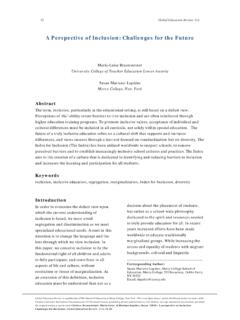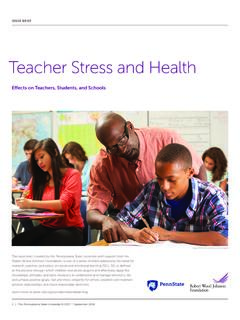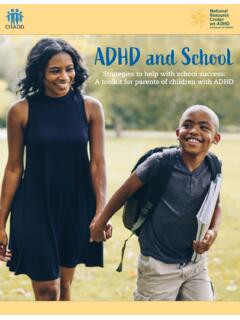Transcription of The Impact of Differentiated Instruction in a Teacher ...
1 International Journal of Higher Education Vol. 2, No. 3; 2013 Published by Sciedu Press 28 ISSN 1927-6044 E-ISSN 1927-6052 The Impact of Differentiated Instruction in a Teacher Education Setting: Successes and challenges Stephen Joseph1, Marlene Thomas1, Gerard Simonette1 & Leela Ramsook1 1 Centre for Education Programmes, The University of Trinidad and Tobago Correspondence: Stephen Joseph, Centre for Education Programmes, The University of Trinidad and Tobago, Valsayn Campus, Old Southern Main Road, Valsayn, Trinidad, W. I. E-mail: Received: May 24, 2013 Accepted: June 14, 2013 Online Published: June 22, 2013 URL: Abstract This study examined the Impact of using a Differentiated instructional approach to teaching second year students pursuing an undergraduate course in curriculum studies at a tertiary institution.
2 These prospective teachers varied in terms of their interests, experiences, personal circumstances, and learning preferences. Four hundred and thirty-four students in two education campuses took the course over a period of one semester. Half of the student body experienced Differentiated Instruction while the other half was exposed to the whole- class instructional approach. At the end of the course, an assessment was made to determine the extent to which Differentiated Instruction had a positive Impact on students general understanding of the course. Findings of the study revealed that students at both campuses responded favourably to the Differentiated instructional approach, with 90% of participants reporting higher levels of intellectual growth and interest in the subject.
3 Assessment of student learning revealed that the majority of students in the Differentiated classrooms demonstrated sound understanding of major concepts taught in the curriculum studies course. Almost all of the students (99%) expressed willingness to experiment with Differentiated Instruction in subsequent practicum sessions during their tenure at the university, and 88% indicated a desire to use a Differentiated instructional approach in their classrooms upon graduation. Keywords: Differentiated Instruction , Teacher education, Tertiary institution 1. Introduction Recent research suggests that while graduates from Teacher education institutions in Trinidad and Tobago generally understand the concept of Differentiated Instruction , they often experience difficulty integrating content, process, and product differentiation in their classrooms (Joseph, 2013).
4 This difficulty may be a result of the failure of Teacher preparation institutions to expose prospective teachers to Differentiated Instruction through classroom teaching and modelling. Given government s burgeoning interest in greater inclusion of all students with special needs, there is an urgent need to address the question of learner variance in classrooms of the nation s schools (Trinidad and Tobago, Ministry of Education, 2008). Sizer (1985), Stradling and Saunders (1993), believe that since educators no longer have the legitimate choice about whether to respond to academically diverse student populations in classrooms, perhaps the time has come for them to decide on how to respond.
5 A close look at Teacher education institutions may reveal that many instructors teach and assess every student in the same way using the same material without paying attention to learner variance. If this is a true picture of our Teacher preparation institutions, then a case can be made for these institutions to transform their programmes to reflect the realities of 21st century schools (Chesley & Jordan, 2012). One way to accomplish this is to emphasize Differentiated Instruction not merely as an instructional strategy, but rather as a critical teaching and learning philosophy that all prospective teachers should be exposed to in Teacher education programmes (Ireh & Ibeneme, 2010).
6 This philosophy, according to Tomlinson and Imbeau (2010), is based on the following set of beliefs: (a) that students who are the same age differ in their readiness to learn, their interests, their styles of learning, their experiences, and their life circumstances; (b) the differences in students are significant enough to make a major Impact on what students need to learn; (c) students will learn best when they can make connections between the curriculum and their interests and life experiences; (d) the central job of schools is to maximize the capacity of each child. Contemporary classroom teachers, therefore, will need to develop classroom routines that attend to, rather than ignore learner International Journal of Higher Education Vol.
7 2, No. 3; 2013 Published by Sciedu Press 29 ISSN 1927-6044 E-ISSN 1927-6052 variance in readiness, interest and learning profile. To achieve this ideal, Teacher education institutions must put in place systems that support effective teaching and modelling of Differentiated Instruction . Tomlinson and Imbeau (2010) describe differentiation as classroom practice with a balanced emphasis on individual students and course content. They posit that at the core of the classroom practice of differentiation is the modification of curriculum-related elements such as content, process and product, based on student readiness, interest, and learning profile.
8 Key elements of Differentiated Instruction Student readiness Theory and recent research support the position that teachers should consciously adjust curriculum and Instruction in response to student readiness, interest, and learning profile. Vygotsky s (1978) theory relating to learner readiness, for example, suggests that teachers should teach within a child s zone of proximal development the difference between what a child can do alone without guidance and what the child can do with scaffolding or support. If the Teacher can push the child into his/her zone of proximal development, and coach with a task slightly more complex than the child can manage alone, then the child, through repetition, will master new skills and learn to become an independent thinker and problem solver.
9 Byrnes (1996) suggests that if material is presented at or below the mastery level, then no growth will occur. In like manner, if material is presented well above the zone, children will be confused and frustrated. Teachers, therefore, must pay attention to student readiness as an important component of Differentiated Instruction . Tomlinson and Imbeau (2010) caution, however, that readiness is not a synonym for ability, and the two terms should not be used interchangeably. For them, readiness suggests a temporary condition that should change regularly as a result of high-quality teaching; whereas ability refers to a fixed state based on some form of innate or inborn trait.
10 Tomlinson (2005a, 2005b) posits that the concept of student readiness encompasses student knowledge, understanding and skills in relation to the Instruction a Teacher is planning. And the goal of readiness differentiation is to ensure that all students are provided with appropriately challenging learning experiences (Santangelo & Tomlinson, 2009). For example, teachers may choose to differentiate based on student readiness by varying the levels of difficulty of the material studied in class (Anderson, 2007). Student interest As in the case of student readiness, addressing student interest can be also important to student academic development.















